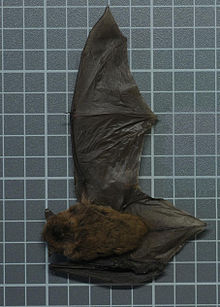Banana pipistrelle
| Banana pipistrelle | |
|---|---|
 |
|
| female from Mukanda River | |
| Scientific classification | |
| Kingdom: | Animalia |
| Phylum: | Chordata |
| Class: | Mammalia |
| Order: | Chiroptera |
| Family: | Vespertilionidae |
| Genus: | Neoromicia |
| Species: | N. nanus |
| Binomial name | |
|
Neoromicia nanus Peters, 1852 |
|
| Synonyms | |
|
Pipistrellus nanus Peters, 1852 |
|
Pipistrellus nanus Peters, 1852
Pipistrellus africanus Rüppell, 1842
The banana pipistrelle (Neoromicia nanus) is a species of vesper bat found throughout much of Africa. It was previously known as Pipistrellus nanus, but genetic analysis has since shown it to be more closely related to other species in the genus Neoromicia.
Banana pipistrelles are unusually small bats, with a total length of about 7 to 8 centimetres (2.8 to 3.1 in), about half of which consists of the tail. Adults weigh only 2 to 4 grams (0.071 to 0.141 oz), although females are slightly larger than males. The fur is dark with golden or reddish brown tips, fading to greyish or near-white tips on the fur of the underparts. The wings are brown, sometimes with a narrow white border on the hind margin. The ears are triangular with a tragus that has been described as "hatchet-shaped".
The thumbs of banana pipistrelles bear an unusual pad composed of ridged hairy skin with multiple sebaceous glands. The surface of the pads overlies a patch of connective tissue and a small piece of cartilage that connects to the end of a muscle. The attachment of this muscle to the pads enables to bat to form them into a cup shape, although it is unclear whether this can form an effective suction cup, rather than simply improving the bat's grip onto objects through friction alone. Most, though not all, individuals also possess a relatively large and visible gland of unknown function on each side of the tail.
Banana pipistrelles are found throughout much of Africa south of the Sahara, except for the Namib and Kalahari deserts. They are found in both lowland and montane rainforests, open savannah, and other wooded areas such as plantations. Six subspecies are currently recognised:
The bats are named for their habit of roosting in the unfurled, tube-like leaves of banana trees and related plants such as plantains. However, they also roost in a variety of other trees with similarly shaped leaves, such as Strelitzia nicolai and sugar plum, as well as in palms, culverts, and holes in buildings. While roosting, at least some banana pipistrelles enter daily torpor during cool weather. Many bats roost alone or in pairs, although colonies of up to 150 individuals are known. Males have been reported to defend particular roosting sites, whereas females regularly travel between different locations, and therefore show no fidelity to particular mating partners.
...
Wikipedia

